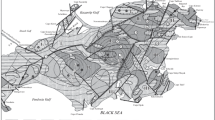Abstract—
The results of the fractal analysis of a drainage network reconstructed using a digital elevation model and the structural and geomorphological analysis of the relief of the Kerch Peninsula are compared. Three sectors with different geomorphological expression and the uplifts and depressions associated with them have been identified by the results of the structural and geomorphological analysis. At the same time, the newest structural geometry does not coincide with the structural geometry that developed until the Late Pliocene period. The neotectonic structures of several orders are distinguished according to the results of the structural and geomorphological analysis. The relationship between the magnitude of the fractal dimension D of the drainage network and the movement direction was found: higher values correspond to uplifts and lower values correspond to depressions. This is due to the fact that the areas of neotectonic uplifts are characterized by the active restructuring of the drainage system and the formation of new streambeds and valleys as well as the branching of streams. The increasing complexity of the river network is seen in the higher values of the fractal dimension D, which is a quantitative measure of the complexity of objects. At the same time, the increased values of the D field correlate with rather large first-order structures. It is also found that the results of fractal analysis are subject to the scale effect, and the sensitivity depends on the accuracy and scale of the data. This should be taken into account in further research. It is shown that the fractal approach is promising for the quantitative analysis of the drainage pattern in the study of the newest tectonic structures.







Similar content being viewed by others
REFERENCES
Chupikova, S.A., Fractal methods for revealing hidden regularity in erosive surface breakdown (the test case of analysis of the Sayan–Tuva Mountains, Republic of Tuva), Abstract of Cand. Sci. (Geogr.) Dissertation, Tomsk, 2010.
Dombradi, E., Timar, G., Bada, G., Cloetingh, S., and Horvath, F., Fractal dimension estimations of drainage network in the Carpathian–Pannonian system, Global and Planet. Change, 2007, vol. 58, pp. 197–213.
Feder, J., Fractals, New York: Springer, 1988; Moscow: Mir, 1991.
Geologiya SSSR (Geology of the USSR), vol. 8: Krym (The Crimea), Part 1: Geologicheskoe opisanie (Geological Description), Muratov, M.V., Ed., Moscow Nedra, 1969.
Gryazevye vulkany Kerchensko–Tamanskoi oblasti: Atlas (Atlas of Grease Volcanoes of the Kerch–Taman Region), Shnyukov, E.F., Sobolevskii, Yu.V., Gnatenko, G.I., Naumenko, P.I., and Kutnii, V.A., Eds., Kiev: Naukova dumka, 1986.
Jenson, S.K. and Domingue, J.O., Extracting topographic structure from digital elevation data for geographic information system analysis, Photogram. Eng. Remote Sens., 1988, vol. 54, no. 11, pp. 1593–1600.
Kalush, Yu.A., Loginov, V.M., and Chupikova, S.A., The use of GIS technologies in the analysis of fractal characteristics of the river network of Tuva, Geoinformatika, 2005, no. 4, pp. 31–40.
Korchuganova, N.I., Kostenko, N.P., and Mezhelovskii, N.N., Neotektonicheskie metody poiskov poleznykh iskopaemykh (Neotectonic Methods of Search for Minerals), Moscow: MPR RF geokart. MGGA, 2001.
Makarova, N.V. and Makarov, V.I., Quaternary tectonic zonality of the Kerch Peninsula, Vestn. Mosk. Univ., Ser. 4: Geol., 1994, no. 4, pp. 20–33.
Mel’nik, M.A. and Pozdnyakov, A.V., Fractal analysis of erosive topography breakdown: Methodological approaches, Vestn. Tomsk. Gos. Univ., 2007, no. 301, pp. 201–205.
Mel’nik, M.A. and Pozdnyakov, A.V., Fractals in the erosive surface breakdown and self-oscillations in the dynamics of geomorphosystems, Geomorfologiya, 2008, no. 3, pp. 86–95.
Muratov, M.V., Kratkii ocherk geologicheskogo stroenie Krymskogo poluostrova (A Brief Outline of the Geological Structure of the Crimean Peninsula), Moscow: Gosgeoltekhizdat, 1960.
Pelletier, J.D., Self-organization and scaling relationships of evolving river networks, J. Geophys. Res., 1999, vol. 104, no. B4, pp. 7359–7375.
Sidorchuk, A.Yu., Fractal geometry of river networks, Geomorfologiya, 2014, no. 1, pp. 3–14.
Turcotte, D.L., Fractals and Chaos in Geology and Geophysics, Cambridge: Cambridge Univ. Press, 1997.
Zakharov, V.S., Analysis of the Characteristics of Self-Similarity of Seismicity and the Active Fault Network of Eurasia, Vestn. Mosk. Univ. Ser. 4: Geol., 2011. no. 6, pp. 10–17. DOI: 10.3103/S0145875211060123
Author information
Authors and Affiliations
Corresponding author
Additional information
Translated by O. Pismenov
Rights and permissions
About this article
Cite this article
Zakharov, V.S., Simonov, D.A., Bryantseva, G.V. et al. Self-Similarity Properties of the Kerch Peninsula Stream Network and Their Comparison with the Results of Structural and Geomorphological Analysis. Izv. Atmos. Ocean. Phys. 55, 721–730 (2019). https://doi.org/10.1134/S0001433819070120
Published:
Issue Date:
DOI: https://doi.org/10.1134/S0001433819070120




